Revolutionary Findings Beneath Antarctic Ice
Deep beneath Antarctica’s massive ice cover, scientists have unveiled startling revelations that could reshape our understanding of climate change. A team led by a CSU seismologist dedicated years to this unprecedented study, focusing on the interaction between the glaciers and the underlying bedrock.
The research revealed that the rock beneath these glaciers is not static; it rises and sinks in response to the ice’s immense weight. This dynamic movement is crucial for more accurate predictions of future sea-level rise.
These findings highlight the importance of understanding geological movements beneath ice sheets, which have significant implications for climate models. Such knowledge is essential for preparing for the potential impacts of global warming.
Dr. Rick Aster, a distinguished geophysics professor at Colorado State University, spearheaded this groundbreaking research. His work has been pivotal in uncovering the mysteries of the Antarctic underground.
Implications of the Study on Climate Predictions
The study’s results, published in Science Advances, offer critical insights into how climate change might affect our planet. The geologic movements beneath the ice are now seen as a key factor in predicting sea-level rise.
Understanding these movements allows scientists to refine their models, leading to more accurate forecasts of climate change impacts. This research underscores the interconnectedness of Earth’s systems.
Key details from the study include:
- Rock movements beneath glaciers
- Impact on sea-level predictions
- Refined climate models
This data is invaluable for policymakers and researchers, helping to shape future climate strategies and adaptation measures.
The Role of Seismology in Climate Science
Seismology played a crucial role in this research, providing unique insights into the hidden dynamics beneath the ice. By monitoring seismic activity, scientists can map the movements of the bedrock with remarkable precision.
This approach has proven to be a powerful tool in climate science, offering a new perspective on how Earth’s inner workings affect surface conditions. The data gathered is pivotal for understanding long-term climate trends.
Seismological techniques can reveal the hidden processes that drive changes in ice sheets and glaciers, offering a new dimension to climate research. This interdisciplinary approach is crucial for holistic understanding.
Dr. Aster’s contributions to seismology have been instrumental in pushing the boundaries of climate science, providing a deeper understanding of the planet’s response to warming.
Future Directions and Research Opportunities
This groundbreaking study opens up numerous avenues for future research. Scientists are now equipped with new tools and insights to explore further the complexities of Antarctica’s ice and bedrock dynamics.
Ongoing research will focus on how these geological movements interact with other climate factors, such as ocean currents and atmospheric conditions. These studies are vital for developing comprehensive climate models.
The collaboration between seismologists, glaciologists, and climate scientists is essential for addressing the multifaceted challenges posed by climate change. Such interdisciplinary efforts will continue to drive progress.
As we delve deeper into the Earth’s mysteries, the knowledge gained will be critical for shaping our response to global climate challenges. The revelations from beneath Antarctica are just the beginning of a new era in climate science.



morgan
Can this new data help predict when and where the next major ice melt will happen?
alice
Why haven’t we heard about these geological movements before? Seems pretty crucial for climate predictions.
Zachary
So the rock beneath the ice is like a giant waterbed? That’s wild! 😂
SophiaWisp
Great job, Dr. Aster and team! This kind of research is what we need to combat climate change. Thank you!
ella_ethereal
Are there any immediate policy changes being suggested based on these findings?
Jordan_Dreamweaver
Wow, this is incredible! How long did it take the CSU team to make this discovery? 🌍